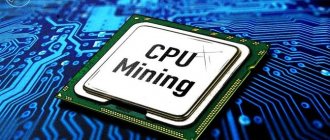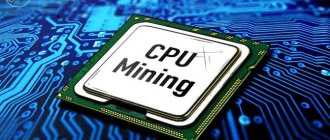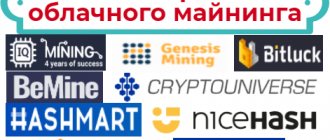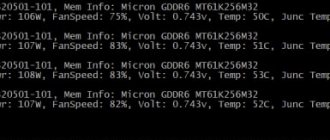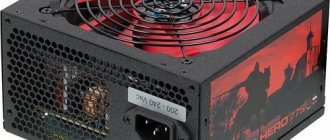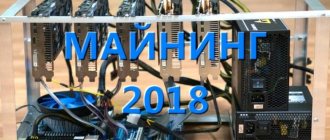Probably every person studying the topic of mining has wondered how profitable it is to mine cryptocurrencies using a processor. After all, the most popular coins are now obtained using video cards or special devices.
Mining on a processor is available to almost every owner of a personal computer. However, due to the ever-increasing complexity of the network of popular cryptocurrencies such as Bitcoin, Ethereum, Litecoin and so on, their mining on the processor has become unprofitable.
But this does not mean that it is absolutely impossible to make money from this type of mining. In this article we will talk about current processors for cryptocurrency mining, profitability and talk about the profitability of this type of receiving tokens.
- What is CPU mining?
- Mining on server processors
- How to mine on a CPU
- Mining on Xeon processor
- How to choose a processor for mining
- Calculators for mining on the NiceHash processor
- My Crypto Buddy
- CryptoCompare
- Claymore's CryptoNote Windows CPU Miner
- Is mining possible on a Bitcoin processor?
What is CPU mining?
Features of mining on a processor
Mining on a processor
is the process of mining cryptocurrency by finding a hash using the computing power of the central processing unit (CPU) and assigning it to a block within the cryptocurrency blockchain.
Mining was first launched on a central processor by the creator of Bitcoin, Satoshi Nakamoto.
☝️
It was with the help of the central processor that Satoshi mined his 1 million BTC.
At the dawn of the era of cryptocurrencies, when a Bitcoin cost a few cents, mining even on a very average central processor was very effective, the only thing was that the price of a Bitcoin of a few cents then compensated for this phenomenon.
Mining on a processor is theoretically possible with cryptocurrencies that support the following algorithms:
- SHA-256;
- X11;
- Ethash;
- Scrypt;
- Equihash.
In theory, because in practice later, with the development of the cryptocurrency industry, the baton of mining was first taken over by video cards, and then by ASIC miners (Application Specific Integrated Circuit) - specialized high-performance devices. The computing power they provided left both central processors and video cards out of the game (with the exception of mining those cryptocurrencies that run on the Ethash or Zhash algorithms).
☝️
At the moment, mining on a processor is unprofitable due to the high complexity of the network and the use of ASICs.
New coins on exchanges
Developers are also trying to enter new exchanges to add their coins there. From more or less adequate exchanges that are actively adding new coins:
- Binance
- coinsbit.io
- hotbit.io
- yobit.io
- Huobi
- pro.coinbase
- kraken
- bitfinex
- en.bithumb.com
- bitstamp.net
The easiest way to keep track of the latest coins added is through accounts on social networks Twitter, Instagram, Facebook, Telegram and email newsletters.
Mining on server processors
Performance of a server processor for mining
A server processor is a more productive and stable modification of a conventional central processor, designed to work in data centers and with a heavy network load.
How is a server processor different from a regular processor? In fact, a server processor has several differences from a regular desktop processor:
It is designed for continuous operation 24/7 and under maximum load. To do this, all server processor instances undergo comprehensive testing under extremely stressful conditions for stability and compliance with the requirements for this type of equipment. Their planned service life is 5 years, under constant load, while the planned service life for a desktop processor is only 3 years and at a lower load.
The number of cores in server processors is greater than in desktop processors. Thus, standard desktop processors have up to 8 cores installed, while in server processors the average number of cores is 12.
Support for large arrays of RAM, so even outdated models of server processors supported up to 144 GB.
Mining on server processors
Another difference between server modification and desktop modification is a different operating principle. The server processor is designed to work with a powerful flow of network data, in fact, in a relative single-tasking mode, while the desktop version works in multi-threading mode with many small tasks.
☝️
Also, server processors for mining are characterized by support for ECC, noise-resistant memory both in the internal cache of the processor at all levels and in RAM.
Mining on server processors is also somewhat more efficient compared to cryptocurrency mining on a regular processor, including due to the larger amount of second-level cache memory in the server modification. But this only works with appropriate support for AES instructions in the server processor model.
The server processor is good for cryptocurrency mining due to its greater reliability and performance, but only in comparison with a regular desktop processor, but video cards and ASICs still outperform it in terms of performance.
In addition, you should understand that a server processor consumes more electricity and costs much more than a desktop processor.
On the server processor you can mine all cryptocurrencies that support the CryptoNote and CryptoNight
.
How to mine on a CPU
Setting up mining on a processor
To start mining on a processor, you need to do the following (using Monero mining as an example):
- Download the mining program.
- Create a wallet to store mined coins.
- Select a suitable mining pool and register in it.
- To start mining on a processor, you will need to create a file with the BAT extension (this is a regular file with a TXT extension, in which you need to change the extension to BAT).
- For example, we took the nanopool pool. Therefore, the following should be written in the file: NsCpuCNMiner64.exe -o stratum+tcp://xmr-eu1.nanopool.org:14444-u Your Monero address -px -pow7 1 -t 2, where 2 is the number of threads for mining Monero.
- Save the file and run it.
- Mining has started.
Note that the number of threads must be selected based on the capabilities of your processor. Each thread requires about 2 MB of cache. For example, on an Intel CPU i7-7700K the total amount of cache memory is 8 MB. Accordingly, there is no point in running more than 4 threads if you plan to use the computer not only for mining, but also for general use.
Mining on Xeon processor
Bitcoin mining
The Intel Xeon processor family is a server line of high-performance CPU models known for their reliability and performance.
In some cases, mining on Intel Xeon server processors is significantly ahead of the same activity on the Intel i7 and i9 family of desktop processors. Thus, the server model Intel Xeon E5-2650 shows a decent result for a CPU of 143 kH/s, while the desktop model Intel Core i7-3960X shows only 101 kH/s.
For comparison: the Nvidia GeForce RTX 2080 Ti video card shows a result of 52.5 Mh/s.
Setting up the mining procedure on a server CPU is no different from setting up desktop models. You need to launch the graphical interface of the program, specify the necessary data there and start the mining process.
How to choose a processor for mining
Equipment for mining cryptocurrencies
When choosing a processor for mining, we are faced with two companies - AMD and Intel. And if you consider that the “red” ones have recently been releasing multi-threaded processors, they are the best choice for mining. But, let's look at CPUs from both companies:
Popular processor models for mining
*Processor prices were taken based on Yandex.Market data
**Let us clarify that although AMD claims improved performance of the new line, in fact it produces the same power when mining. And in the case of some algorithms, even worse than previous models.
*** The presented profitability and payback are calculated without taking into account the cost of electricity.
****Payback periods, as well as profitability, depend on the exchange rate of cryptocurrencies and USD.
It is also worth considering that new processors from Intel, the cost of which is significantly higher than 20,000 rubles, are not recommended for mining. Firstly, the payback period is significantly more than two years. Secondly, the processor must work all this time, which means there is a high risk of failure.
And if you consider that in addition to the processor you need the same powerful motherboard and cooling system, the new equipment will not exactly pay for itself.
☝️
Enthusiasts who are still mining on processors prefer to buy used equipment. In this case, it pays off in about a year.
If we talk about server processors, then mining on them is profitable only if they support encryption using the AES (Advanced Encryption Standard) algorithm. For example, even a new CPU that does not have built-in AES will have lower performance than an old Pentium or Intel i3, but with support for this feature.
How to choose a processor for cryptocurrency mining in 2022 is described in detail in the video below (the trends have not changed since 2022):
Mining on the processor 2021
RandomX algorithm coins
When it comes to choosing a RandomX coin, it all depends on the current market. We will list several of the most popular coins of this algorithm. Please note that some coins may not only be of the RandomX algorithm, but in fact they all originated from it, and are mined in the same way, these are just forks of the RandomX algorithm.
Keep in mind that this list changes (adds) every month as more and more projects begin to migrate to RandomX:
- Monero (XMR)
- Epic Cash (EPIC)
- DinastyCoin (DCY)
- YadaCoin (YADA)
- DERO (in progress)
- LuxCore (LUX)
- Loki (Loki)
- Wownero (WOW)
- ArQma (ARQ)
CPU mining calculators
Calculating the profitability of mining on a processor CPU
mining calculators provide information with a detailed calculation of the profitability of mining cryptocurrencies. As a rule, these are the same online platforms that calculate the cost of mining for video cards and ASICs. Based on certain algorithms and cryptocurrency quotes, these services calculate the profitability of mining in real time, i.e., according to the current cryptocurrency exchange rate.
The services are designed according to a simple principle: you enter the name of the central processor model, the cost of electricity in your region and receive a list of the required cryptocurrencies, usually with detailed information about which of them is the most profitable in a given period of time.
☝️
Read the full article: Mining calculator: how to calculate the profitability of Bitcoin and cryptocurrencies
A list of the most convenient calculators for mining on a processor is below.
NiceHash
☝️
Link to NiceHash calculator
An excellent mining calculator that initially provides calculations for the associated cloud mining service and marketplace for trading remote mining capacity. Simple, clear and convenient. The service supports as many as 24 algorithms.
As an example of using a mining calculator, we will calculate mining on two different central processors, two desktop ones from Intel and AMD, and one server one using the NiceHash calculator.
We will take the best models with high performance for the most up-to-date picture possible.
The first example: the top-end central processor from AMD - AMD CPU Threadripper 1900X.
Mining income calculation on AMD CPU Threadripper 1900X processor
As we can see, even if mining on a very powerful processor provides profitability, it is very relative, especially compared to the same indicators from video cards and ASICs.
Second example: a central processor from Intel - Intel CPU i9-9980XE:
Calculation of mining income on the Intel CPU i9-9980XE processor
The screenshot shows that in the case of even such a powerful processor, mining on central processors, even if it has profitability, is very relative.
☝️
Read the full article:
My Crypto Buddy
An excellent calculator for cryptocurrency mining, also with the ability to calculate the difficulty of mining and determine commissions from large mining pools. All this data is presented to the user through an advanced approach in the original report.
☝️
Link to My Crypto Buddy calculator
CryptoCompare
Convenient and intuitive mining calculator. Provides users with only three fields, with the hashrate of mining equipment, its energy consumption and the price of electricity, by filling which, users will receive the necessary information about the profitability of mining.
☝️
Link to CryptoCompare calculator
Best Cryptocurrency Mining Sites
I already wrote an article about how you can even mine cryptocurrency from your phone. It describes the applications, as well as the disadvantages and advantages of this method.
There are three types of cryptocurrency mining sites: pools, browser miners and cloud services. The first are one or more servers that distribute calculations for block formation among connected miners. The pool sends a block with a hashed signature to the network, and the received reward minus its commission is divided among the participants in proportion to the volume of production capacity.
IMPORTANT. Due to the growing complexity of calculating coins from the TOP capitalization, today it is almost impossible to mine on your own. It will take years to form a new block, even if you use a home farm of 8 video cards.
Browser miners use the processing power of a PC for calculations and only require an Internet connection. But you can’t make a lot of money with their help.
Cloud services allow investors to rent part of the production capacity of their servers and receive passive income. However, there are many scammers and scams in this area.
The table below lists the best sites that are trusted by most private miners. With the right choice of the mined cryptocurrency, such services allow you to earn a good income.
Table 1 “Where is the best place to mine cryptocurrency”
| Best pools | The best browser miners | The best services for cloud mining |
| · ethermine.org; · nanopool.org; f2pool.com; · unimining.net; slushpool.com. | freebitco.in; · browsermine.com; · minergate.com. | iqmining.com; bitdeer.com; · bemine.club; hashflare.io; · hashing24.com. |
I also advise you to read an article about whether it is worth investing in cryptocurrency if you are suddenly thinking about investing.
How to choose a program for mining on a processor
Software for mining on processors
Programs for mining on a processor act as an intermediary between the user’s equipment, the mining pool and the blockchain of the selected cryptocurrency.
It is worth choosing time-tested mining programs and downloading them only from the official resource, since third-party sources can provide the user with infected software for hidden mining.
☝️
Read the full article: Mining software: how to choose the best software
Reliable CPU mining programs are described below.
Claymore's CryptoNote Windows CPU Miner
An excellent mining client running on the CryptoNote algorithm with a wide range of customization and no commission for the developer. The program provides all the possibilities for mining on the central processor, both desktop and server modifications.
☝️
Claymore's CryptoNote Windows CPU Miner Download Link
XMRig miner
This mining client provides standard options for setting up mining on the central processor.
☝️
The program charges users a commission of 5% by default, but if you set the donation level to 1, then the user commission to the developer will be 1%.
For successful operation, you must provide the program with administrator access. XMRig miner also allows you to configure the number of threads for the central processor, which allows you to fine-tune your mining.
However, you need to take into account that each thread requires 2 MB of second-level cache, so not all mid-range processors such as the Intel CPU i7-7700K will support a mode with more than 4 threads.
☝️
Download link XMRig miner
Bloggers on YouTube and Telegram
To keep up to date with the latest and most relevant information on new coins and in general, I recommend that you subscribe to bloggers’ YouTube and telegram channels. Below is a list of those I personally watch:
- Crypto Max
- KOLYA MINER
- The4atlanin
- PRO Mining Belarus
- Bitcoin - cryptocurrency mining experience [BitExpmcc]
- Tomer's novel
- ValeraTV
- Proton
- CryptoLeo
- Serega Soleniy miner
- Mongol Kombat
- Prometheus
I did not indicate telegram channels, since they can be found by going to the YouTube channel and seeing links in the headers or description of the channel or under the video.
Mining on a processor and on video cards - differences
Mining on video cards
Probably one of the main differences between mining cryptocurrencies on a processor and video cards is too little profit or no profit at all. But at the same time, mining on a CPU is more accessible, since even average personal computers have a relatively good processor.
The CPU is responsible for software tasks that control all components of a personal computer, laptop, or any other device. The processor, to some extent, manages all components, makes decisions and issues commands to programs.
The GPU, in turn, is responsible for processing graphics and displaying images on a monitor connected to a personal computer or other equipment. Unlike the CPU, the video card does not issue any commands, but rather executes them.
At the same time, video cards use a faster type of memory compared to processors, which in the context of mining means high throughput for parallel calculations.
☝️
The CPU can handle one or two threads per core, while the GPU throughput is in the thousands per multiprocessor.
It turns out that even from a technical point of view, the difference between a processor and a video card is huge. And when it comes to mining, performance plays an important role.
AMD Ryzen 7 1800X
RYZEN 1800X features 8 cores, 16 threads and a thermal power of 95w. Despite being half as powerful as the Threadripper 1950x beast, the Ryzen 7 offers excellent multi-threaded performance - it can also be easily overclocked. Although this CPU processor is considered expensive for a high-end desktop processor, for crypto mining on a processor, it is actually quite affordable and quite economical.
Buy on Amazon Buy on eBay
Technical requirements
- Cores: 8
- Base frequency - 3.6 GHz
- Boost CL clock-4GHz
- L3 Cache-16MB
- Streams-16
- Thermal design power (TDP) – 95W
pros
- Easy to accelerate
- Available for mining
- Low voltage
Minuses
- Not nearly as powerful as Threadripper 1950x
Which cryptocurrencies are profitable to mine on a processor in 2021?
What cryptocurrencies to mine in 2020
In 2022, mining cryptocurrency on a central processor is practically unprofitable
, due to the takeover of the mining industry by more productive ASICs and video cards for mining.
Is mining possible on a Bitcoin processor?
Mining Bitcoin (BTC) cryptocurrency on a central processor is unprofitable due to the high complexity of the network and the huge number of ASICs operating in it.
☝️
An article about how to mine Bitcoin correctly and profitably
Is it worth mining Ethereum on a CPU?
The cryptocurrency Ethereum (ETH), as one of the most popular coins, is of great interest to miners, but like Bitcoin, due to the high complexity of the network, it is unprofitable when mining it on a central processor.
☝️
An article on how to mine Ethereum correctly and profitably
How to mine Monero on a CPU
Mining Monero
The anonymous cryptocurrency Monero (XMR) is also popular with miners, but unlike the first two, it can be mined on a central processor. Monero can be successfully mined on a CPU if the miner has powerful processors such as Intel CPU i7-9750H or Intel CPU i9-9980XE, and preferably in sufficiently large quantities.
☝️
Also, do not forget about the need to connect your system to a mining pool; in solo mode, mining Monero will simply be unprofitable.
Profitability of mining Dogecoin on a CPU
The meme cryptocurrency Dogecoin (DOGE) can be mined until 2022, if the user has several central processors of the Intel CPU i9-9980XE level and is connected to a mining pool.
However, in 2022, due to the high level of hype around the Dogecoin cryptocurrency, its mining using a processor is unprofitable.
☝️
Read the full article: Mining Dogecoin: is it profitable to do it?
Is it possible to mine Zcash on a CPU?
Another anonymous cryptocurrency, Zcash (ZEC), is often used by hackers, but since it is accepted on a number of large cryptocurrency exchanges, it is also of interest to miners. However, its network complexity and cost on the market are such that mining it on a central processor is simply unprofitable.
☝️
Read the full article: Zcash mining: setup, calculator and best mining pools
Epilogue
The situation in the field of mining virtual coins using GPU processors is constantly changing. The reason is the periodic appearance of new devices . For example, last year NVIDIA and AMD launched the latest version of gadgets onto the market, which are more energy efficient than cards released a little earlier. There is also a differentiation of “miners” into two camps – those who can mint Ether on their hardware and miners who are lagging behind technical progress. The boundary passes through the video buffer level of 5 GB - at the beginning of this year, this is exactly the value required for Ether mining. As a result, projects with a video memory capacity of 8 GB or more - Octopus, GRIN, Cortex, and other coins. However, there are ecosystems that do not abandon owners of processors with 4 GB or less. An eloquent example is Ethereum Classic, which switched from the Ethash protocol to ETCHash for coin mining on equipment with a video buffer capacity of 3–4 GB.
Average rating 4.3 / 5. Number of ratings: 6
No ratings yet. Be the first to rate.
Pros and cons of CPU mining
Pros and cons of mining on a processor
Pros:
With a powerful processor that allows you to mine cryptocurrency and work in parallel, you can have a small passive income.
You can try to mine a coin that is not very popular, but in larger quantities than a popular one. And if it ever takes off, there is a chance to make a good profit.
Minuses:
To make any profit you need a really good processor and preferably a multi-threaded one;
In the case of expensive electricity, mining on most processors becomes unprofitable;
Even if you purchased the most expensive and top-end processor, mining coins such as Bitcoin, Ethereum, Litecoin and other popular tokens will be unprofitable;
You need to monitor the CPU even better than a GPU farm. And if the processor burns out, there is a high probability that the motherboard will also be destroyed. All this will cost a pretty penny.
List of new coins on Coinmarketcap
First, let's go to the already familiar Coinmarketcap . There is a special section with fresh coins. You can get acquainted with it using this link.
You should understand the difference between new coins and tokens. After all, the former can be mined, but the latter cannot. Previously, the list was regularly updated with new coins; now tokens predominate. It has become not so easy to distinguish one from another. You need to carefully read and analyze the values in the Circulating Supply column.
What is better to mine on a processor in 2022
What is CPU mining?
☝️
In 2022, CPU mining of any known cryptocurrency will be either unprofitable or marginally profitable.
But as an option, it is possible to mine little-known cryptocurrencies, followed by their storage in the hope of being sold during a pump on a crypto exchange. However, you should understand that some cryptocurrencies may remain in your wallet without the ability to exchange them for fiat money. This is due both to the lack of demand for such cryptocurrencies and the reluctance of cryptocurrency exchanges to list such coins.
It is also worth saying that mining on a processor in 2022, although possible, brings very little profit compared to video cards, and even more so with ASICs. Even the most powerful processor is inferior to the GPU.
Depending on the number of cores, a single processor core can process four 32-bit instructions per clock (SSE) or eight 32-bit instructions per clock (AVX). In turn, the video card is capable of processing 3200 32-bit instructions per clock. Thus, GPU performance is hundreds of times higher than CPU.
What cryptocurrencies to mine on a processor
Also, most blockchains use mechanisms to adapt the complexity of calculations so that the time to find each block is constant. That is why, as computing power on the network increases, the difficulty of finding blocks also increases.
In this regard, there are only a few cryptocurrencies whose mining on a CPU can generate at least some income. Such coins are optimized for mining on processors, which is associated with an increased level of network security.
To a greater extent, these include coins that work on the CryptoNote scheme and CryptoNight algorithms (CryptoNightV7, CryptoNightV8, CryptoNightR, CryptoNightHeavy and others).
☝️
The most proven and well-known coin that uses these algorithms is the Monero cryptocurrency.
Other algorithms on which it is theoretically possible to mine cryptocurrency using the CPU:
- SHA-256 (little-known Bitcoin forks);
- X11 (Dash, Pura and others);
- Ethash (Ethereum, Ethereum Classic and other ERC-20 coins);
- Scrypt (Litecoin, Dogecoin and others);
- Equihash (Zcash).
☝️
Attention! The complexity of the network of such coins as Bitcoin, Litecoin, Ethereum and even Zcash has grown so much by 20202 that it practically does not allow making a profit when mining on processors.
AMD Ryzen Threadripper 1950X
Threadripper 1950X is an extremely powerful CPU crypto mining tool. With 16 cores, 32 thread engines, and 32MB of L3 cache, the processor can outperform certain GPUs. These impressive specifications mean that it is well suited for mining altcoins, especially those encoded with the CPU-friendly algorithm, Cryptonight.
Buy on Amazon Buy on eBay
Technical requirements
- Cores: 16
- Base frequency: 3.4 GHz
- Boost CL GHz-4.0 GHz
- L3 Cache: 32 MB
- Streams: 32
- Thermal design power (TDP): 180W
pros
- Easy installation
- Very powerful
- Can outperform many GPUs
Minuses
- energy-intensive
